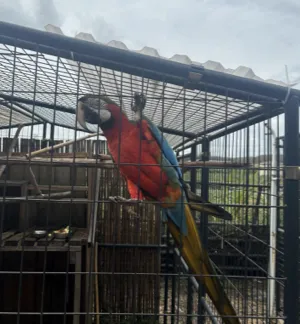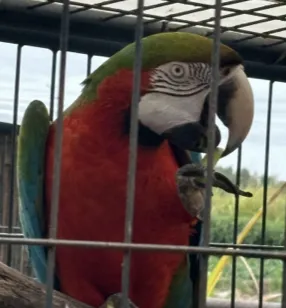


Macaw
by: Elan Saranga
Guess how long the lifespan of a Harlequin Macaw is.
If you guessed anywhere between 50-80 years you are correct!
Overview:
● Harlequin Macaws are not naturally occurring in the wild. They are a man-made hybrid species created by breeding Blue and Gold Macaws with Green-winged Macaws in captivity. This is done primarily for aesthetic purposes
● Harlequin Macaws primarily live in captivity as they are a man-made hybrid species bred in captivity. However, their parent species, the Blue and Gold Macaw and the Green-winged Macaw, are native to South America, where they inhabit various forested regions such as tropical rainforests, savannas, and woodlands.
● The Harlequin Macaw does not have a natural habitat in the wild. However, they are typically kept as companion birds in various environments around the world, primarily in households where they receive care and attention from their owners.
Physical Description:
These macaws are large parrots with a vibrant and striking appearance. They typically have a large, sturdy body, a strong beak, and a long, graceful tail. Their plumage displays a colorful mix of blues, greens, golds, and reds, often with intricate patterns and markings. The Harlequin Macaw's facial features typically include a bare, featherless patch around the eyes and beak, which may vary in color depending on individual genetics.
Diet and Eating Habits:
Harlequin Macaws have a varied diet similar to their parent species, including seeds, nuts, fruits, and vegetables. They enjoy cracking nuts and seeds with their strong beaks and relish fresh produce. Providing a balanced diet and opportunities for foraging keeps them healthy and stimulated.
Behavior and Personality:
Harlequin Macaws are intelligent, social, and affectionate birds. They thrive on interaction and mental stimulation, requiring ample playtime and attention. While they can form strong bonds with their owners, they may display territorial behaviors if stressed. Overall, they make rewarding companions for experienced bird owners.
Domestication and Uses: Harlequin Macaws are bred for the pet trade and primarily serve as companion animals due to
their vibrant appearance and sociable nature. They are popular among bird enthusiasts and may also participate in educational programs and therapy activities. Proper care, including socialization and veterinary attention, is crucial for their well-being.
Cultural Significance:
Harlequin Macaws are prized as exotic pets, symbolizing beauty and wealth. They feature in art and media as luxurious companions. In some South American cultures, macaws hold historical and spiritual significance. They also serve as ambassadors for conservation, highlighting the importance of protecting their natural habitats.
Economic Importance:
Harlequin Macaws hold economic significance in the pet industry, contributing to trade revenue and stimulating sectors like pet care and veterinary services. They also indirectly support conservation through captive breeding programs and public awareness initiatives. However, ethical considerations regarding animal welfare and conservation are paramount in their trade and ownership.
Conservation Status:
The Harlequin Macaw itself doesn't have a conservation status as it's a hybrid bred in captivity. However, its parent species, the Blue and Gold Macaw and the Green-winged Macaw, are both classified as "Least Concern" by the IUCN Red List. Despite this, they face threats like habitat loss and illegal trade, requiring conservation efforts to ensure their survival.
Takeaway:
The Harlequin Macaw is a visually stunning hybrid bird, bred from the Blue and Gold Macaw and the Green-winged Macaw. Known for its vibrant colors and striking appearance, it symbolizes beauty and companionship in the pet industry. While it doesn't have a conservation
status itself, its parent species face threats like habitat loss and illegal trade, necessitating conservation efforts. Responsible ownership and conservation awareness are crucial for the well-being of these birds and the preservation of their wild counterparts.
